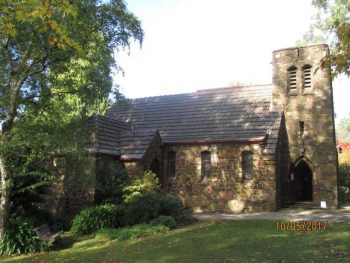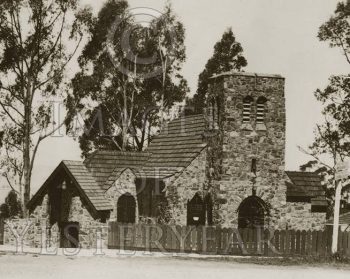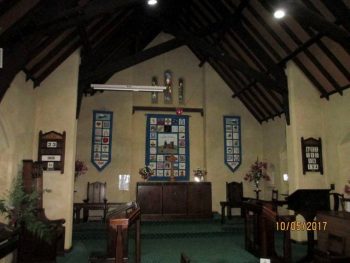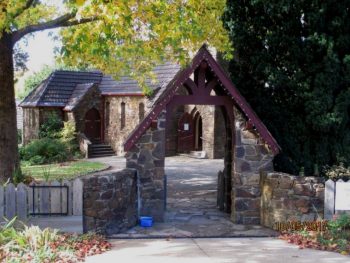Chaplains at War: Revd. Oscar Muspratt
The Rev. Oscar Muspratt’s Australian church
A visit to the Rev. Oscar Muspratt’s Australian church
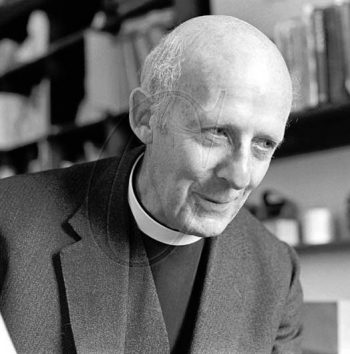 The Revd. Oscar Muspratt, who died in March of this year (2000), was the Vicar of Holy Trinity Penn between 1944 and 1989. 45 years of service one would think was enough for anyone but Oscar did so much before he came to Penn.
The Revd. Oscar Muspratt, who died in March of this year (2000), was the Vicar of Holy Trinity Penn between 1944 and 1989. 45 years of service one would think was enough for anyone but Oscar did so much before he came to Penn.
Oscar Muspratt born in Rochford, Essex, in 1906. Oscar moved, with his family, to Australia in 1920 and at the age of 14 worked as a bullock cart driver and supported his father on a small dairy farm as a labourer. Due to the kindness of a cousin of his father Oscar was able to study chemistry at Melbourne University and became captain of the University Rugby Team.
It was in 1926 that he had what he called “a spiritual experience” which led him to enter the Church Ministry; intending to become a missionary in China. The Chinese considered this an appropriate time to prohibit any more missionaries from entering their country, and so Oscar began his Curacy in Melbourne.
In 1936, Oscar obtained a fellowship at Cambridge, where he supplemented his grant by taking services in local churches. At one of these he met Margaret Hooton, the incumbent’s daughter and they were married in 1st June 1937 in Cambridge. They then returned to Australia where he became Vicar of Dandenong Mountains, and his first task was to rebuild the parish church. Here he honed his conscripting skills as he cadged, cajoled and coerced his small congregation and former university friends to help design and build the beautiful St. Michael’s and All Angels Church in Kalorama. A church and congregation that remained deep in his affection for the rest of his life.
Oscar became a serving chaplain in the 2nd World War and was posted to Egypt during the battles of El Alemain, Malta during their blitz, the initial invasions of Sicily and Italy and the Normandy landings.
And so to Penn. Oscar became the Army chaplain for Buckinghamshire where he met Richard, Viscount Curzon and subsequently the Earl Howe. As the future patron of Penn Church, which was then without a clergyman, he invited Oscar to become the Vicar of Penn Church.
He was demobilised in 1945, and began the restoration and development of Penn Church and its parish. A labour of love that occupied him for the next 45 years. He reintroduced the Church Choir, of which he was so proud, and the restoration of Penn Church’s tradition of bell ringing. The building of the Lady Chapel and construction and repositioning of the new organ. The re-roofing of the church, the extension of the cemetery and the restoration of the long window on the north wall.
His moments in Penn gave Oscar moments of great happiness. Special personal highlights were the development of links between Penn and Pennsylvania; receiving the Freedom of Pittsburgh; being the guest of the US Senate; the establishment of the Penn Pennsylvania Fellowship Trust and the Penn Mead home.
Oscar’s wife Margaret took ill and died in 1976.
When he retired in 1989 Oscar was in poor health and to the pleasure of all who knew him, in 1990 Oscar married Vera who had cared for him at his lowest times. Vera’s effect on Oscar was wonderful. He made a good recovery, throwing away his walking stick.
In 1995 Oscar and Vera bought their lovely bungalow in Brecon. There Oscar spent his time writing his recollections and his treatise on World Peace, while Vera created a beautiful garden in which Oscar took as much pride as if he had made it himself.
Over the past 2 years, Oscar’s health worsened. He had difficulty in walking, but his happiness in Brecon with Vera was great. He passed away on the morning of 8th March 2000, after an intestinal aneurysm.
So that was a little part of the man you may have known as Oscar. A suitable epitaph should be the words of Wordsworth. ‘That best portion of a good man’s life. His little nameless unremembered acts of kindness and love.
We are indebted to Derek Evans for most of the above.
Chaplains at War
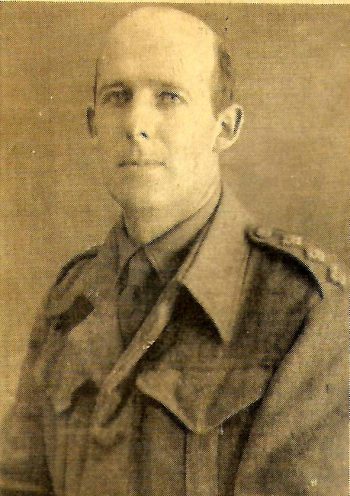 From an article found on ‘Chaplains at War’Oscar Muspratt enlisted in the Army January 1941 upon his return from Australia. He was posted to the 1st battalion the Rifle Brigade (which he shared with the 2nd Battalion the KRRC) in the 1st Armoured division recovering from Dunkirk. During his 2 1/2 years war service in the Middle East he tended the wounded and dying from both the first and the second battles of El Alamein.
From an article found on ‘Chaplains at War’Oscar Muspratt enlisted in the Army January 1941 upon his return from Australia. He was posted to the 1st battalion the Rifle Brigade (which he shared with the 2nd Battalion the KRRC) in the 1st Armoured division recovering from Dunkirk. During his 2 1/2 years war service in the Middle East he tended the wounded and dying from both the first and the second battles of El Alamein.
Volunteering to replace casualties at the height of the blitz on Malta, he became the gunners chaplain. This involved taking countless services with a handful of men manning the great number of anti-aircraft guns in their open gun-pits: these went on even during an actual air raid under standing orders, whilst all hell was let loose overhead.
During the invasion of Sicily, he was posted to the famous 51st Highland division and returned with them for the Normandy Invasion. As his wife was unfortunately faced with a major operation, he was made responsible instead for supervising the spiritual ministrations to the many scattered Army detachments throughout the county of Buckinghamshire. As a precaution, in case London had been hopelessly crippled by bombing, a great part of the key administration of Britain’s war effort was duplicated and scattered throughout eh county of Buckinghamshire. As chaplain he served a wide range of these often most secret and most vital establishments including Chequers and the troops who guarded Winston Churchill.
He was released from the Army service owing to his wife’s serious ill-health at that time and appointed to Penn by Earl Howe in response to the parishioners’ request for an ex-Service Chaplain.
His great grandfather James Muspratt was one of the founders of Britain’s heavy chemical industry in 1825.
From Crockford’s Clerical Directory:
Trained at Ridley College, Melbourne, Australia
Deaconed in 1929 and priested in 1931 in Melbourne, Australia
Churches:
1929-1933 St Mary’s, Caulfield, Australia
1933-1936 Panton Hill, Australia
1936-1937 permitted to officiate Canterbury diocese
1938 priest in charge at St Mark’s, Fitzroy, Australia
1938-1941 Minister of Mt Dandenong, Australia
1941-1945 Chaplain to the Forces
1947 Honorary Chaplain to the Forces
1948-1989 Vicar of Penn, Oxford Diocese, UK
1990 retired and moved to Brecon.
The Rev. Oscar Muspratt’s Australian church
One of our former Vicar’s proudest achievements was that, in 1940, during the darkest days of the Second World War, he had inspired the building of a beautiful new church at Kalorama, 2,000 feet up in the hills of Mt Dandenong, surrounded by eucalyptus trees, with a distant view of Melbourne, 25 miles away to the north west.
Oscar Muspratt was 31 when he arrived at Mt Dandenong in 1938. He had been ordained for nine years, working as a priest in a succession of parishes in the Melbourne area with a 2-year curacy in England where he met and married his first wife at Cambridge. A wealthy parishioner, Ernest Jones, died soon after his arrival at Mt Dandenong and his widow agreed that the building of a new church at Kalorama would be a worthy memorial to him.
The chosen architect was Keith Reed, an old friend and former team-mate from the Melbourne University rugby team, of which Oscar had been captain. The design for a 60-seat church was debated and there were supporters for both a log cabin style and for a clinker brick clad church, but the final choice was for local (Kilsyth) stone. This stone was found only a few miles away and came in soft varied tones of cream, buff, brown and grey. It was decided to follow the Early English style with a small tower and was to cost about £1,400 of which £1,000 was the gift from Mrs Jones.
Oscar Muspratt chose the name St Michael and all Angels for the church, inspired by the Battle of Britain which was being fought in the skies over England at that very time. He had found a text in Revelation Ch 12, v7, ‘there was war in heaven, Michael and his angels fought against the dragon…and the dragon prevailed not’.
The foundation stone was laid on 26 June 1940, the day France fell, when it seemed that the whole future of Christian civilisation was at stake. ‘A giant struggle lies ahead of the world and our Empire in particular’ he wrote in his church newsletter. The church was completed in five frenetic months and was consecrated by the Archbishop of Melbourne on 28 November 1940.
The final cost of building was £1,835, nearly double Mrs Jones’ original offer, but she agreed to meet the whole of it leaving only the furnishings to the congregation. Oscar Muspratt was remembered as the prime mover behind the project. ‘He pushed – no church would have been built otherwise’. The architect had vivid memories of the Vicar ‘being on the ball all the time, up there every day’.
The Muspratts left Australia in January 1941, only two months after the consecration, bound for England and volunteer war service as an Army Chaplain. Keith Reed also volunteered for the Forces. Oscar Muspratt returned several times in later years, most recently with his second wife, Vera, in 1990, for the 50th anniversary of the church.
The church has been described as an architectural gem and people come from miles around to be married there. The two photographs reproduced here confirm that it is a most attractive church.
Perhaps we should consider some formal arrangement for linking our two churches? A good few of us will travel to Australia from time to time and it is easily accessible from Melbourne.
I have taken all the detail for this article from a detailed history of the church called ‘A light in the Hills’, written by H.L.Speagle in 1990, as well as checking with Vera Muspratt’s own knowledge of the church. A copy of the history can be found in the Parish Office.
Miles Green, 22 December 2000
A visit to the Rev. Oscar Muspratt’s Australian church
I wrote in our Newsletter two years ago (Feb/Mar 2001) about the small stone clad church at Kalorama, near Melbourne, for which the foundation stone was laid on 26 June 1940, the day France fell. The building of this church was very much a product of the enormous enthusiasm and energy of the young Vicar, Oscar Muspratt, who was to be our Vicar from 1944-89.
This August, our family holiday was spent in Australia visiting my wife’s mother who lives at Ballarat, about 80 miles west of Melbourne. We set off early one Sunday morning with our two younger children on a 2½ hour car journey through Melbourne’s suburbs, to Kalorama, about 25 miles east of the city. It is about 2000ft up in the wooded (mainly eucalyptus) hills of Mt Dandenong, a lovely area popular with Melbourne residents and tourists.
The church is just to one side of the road with a long view of the open lowlands behind it. It is clad with the local stone in soft, varied tones of cream, buff, brown and grey and looks very neat and established. It seats 60 people (about one third the size of Penn) and is apparently immensely popular for weddings and funerals with people coming on occasions from as far away as New Zealand.
We were met by Henry Speagle, the author of a very well written and detailed history of the church (available in our Church Office), who had been kindly forewarned by Vera Muspratt, Oscar’s widow. The service was entirely familiar based entirely on the Book of Common Prayer, even including a prayer for the Queen and her Ministers. We were warmly welcomed as representatives of Oscar Muspratt’s other church. The congregation was on the elderly side, although there is apparently an active youth group and familiar sports jackets and corduroy trousers were in evidence. Tea and biscuits in the nearby hall and a tour of the church followed the service.
Jean and Henry Speagle invited us to lunch and we found much in common. His generation of Australians was educated as if in an English school with no mention at all of Australian history. He was very knowlegeable about Anglican personalities and had been particularly impressed by Rowan Williams who he had heard preaching. The Melbourne diocesan newspaper was full of the appointment and its likely consequences for the Anglican Church.
It was a most interesting visit. We received the friendliest of welcomes and I recommend Kalorama to future visitors to Melbourne.
Miles Green, 10th September 2002

